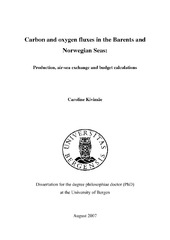| dc.description.abstract | This thesis focus on the carbon and oxygen fluxes in the Barents and Norwegian Seas and presents four studies where the main topics are variability of biological production, air-sea exchange and budget calculations. The world ocean is the largest short term reservoir of carbon on Earth, consequently it has the potential to control the atmospheric concentrations of carbon dioxide (CO2) and has already taken up ~50 % of the antropogenically emitted CO2. It is thus important to study carbon related processes in the ocean to understand their changes in the past, present, and future perspectives. The main function of the Arctic Mediterranean, within which the study area lies, in the global carbon cycle is to take up CO2 from the atmosphere and, as part of the northern limb of the global thermohaline circulation, to convey surface water to the ocean interior. A carbon budget is constructed for the Barents Sea to study the carbon fluxes into and out of the area. The budget includes advection, air-sea exchange, river runoff, land sources and sedimentation. The results reviel that ~5.6 Gt C annually is exchanged through the boundaries of the Barents Sea mainly due to advection, and that the carbon sources within the Barents Sea itself are larger than the sinks. The change in carbon content of the Atlantic Water as it passes through the Barents Sea is investigated, revieling that ~0.030 Gt C is taken up from the atmosphere and exported to the Arctic Ocean during one year. The main part of the increased carbon content is channelled through biological production. Spatial and interannual variability of biological production and air-sea exchange is investigated in the north-western Barents Sea during the spring-summer season, interannual variability of oxygen and carbon fluxes due to biological production is also studied at Ocean Weather Station M in the Norwegian Sea. Both the spatial and interannual variability in the Barents Sea depend on the distribution of water masses and sea ice cover while the causes behind the variability at Ocean Weather Station M are more complex. Air-sea exchange was also studied in the Storfjorden polynya where it was discovered that formation of sea ice during winter is accompanied by a large air-sea CO2 exchange. | en_US |
